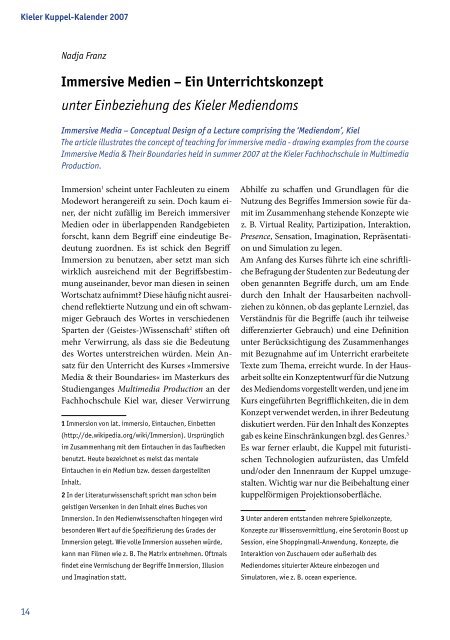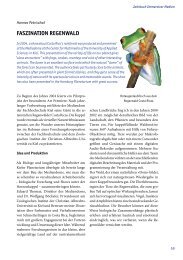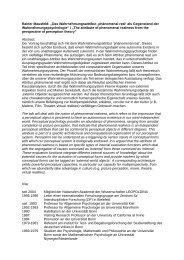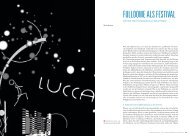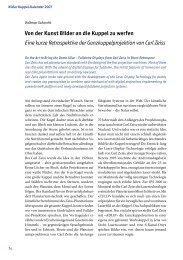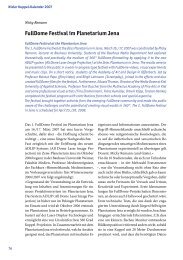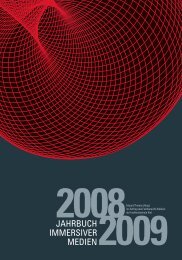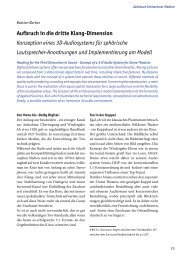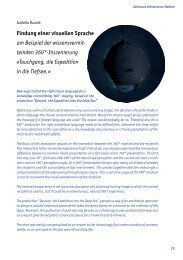Immersive Medien - Ein Unterrichtskonzept
Immersive Medien - Ein Unterrichtskonzept
Immersive Medien - Ein Unterrichtskonzept
Create successful ePaper yourself
Turn your PDF publications into a flip-book with our unique Google optimized e-Paper software.
Kieler Kuppel-Kalender 2007<br />
Nadja Franz<br />
<strong>Immersive</strong> <strong>Medien</strong> − <strong>Ein</strong> <strong>Unterrichtskonzept</strong><br />
unter <strong>Ein</strong>beziehung des Kieler <strong>Medien</strong>doms<br />
<strong>Immersive</strong> Media – Conceptual Design of a Lecture comprising the ‘<strong>Medien</strong>dom’, Kiel<br />
The article illustrates the concept of teaching for immersive media - drawing examples from the course<br />
<strong>Immersive</strong> Media & Their Boundaries held in summer 2007 at the Kieler Fachhochschule in Multimedia<br />
Production.<br />
Immersion 1 scheint unter Fachleuten zu einem<br />
Modewort herangereit zu sein. Doch kaum einer,<br />
der nicht zufällig im Bereich immersiver<br />
<strong>Medien</strong> oder in überlappenden Randgebieten<br />
forscht, kann dem Begrif eine eindeutige Bedeutung<br />
zuordnen. Es ist schick den Begrif<br />
Immersion zu benutzen, aber setzt man sich<br />
wirklich ausreichend mit der Begrifsbestimmung<br />
auseinander, bevor man diesen in seinen<br />
Wortschatz aufnimmt? Diese häuig nicht ausreichend<br />
relektierte Nutzung und ein ot schwammiger<br />
Gebrauch des Wortes in verschiedenen<br />
Sparten der (Geistes-)Wissenschat 2 stiten ot<br />
mehr Verwirrung, als dass sie die Bedeutung<br />
des Wortes unterstreichen würden. Mein Ansatz<br />
für den Unterricht des Kurses »<strong>Immersive</strong><br />
Media & their Boundaries« im Masterkurs des<br />
Studienganges Multimedia Production an der<br />
Fachhochschule Kiel war, dieser Verwirrung<br />
1 Immersion von lat. immersio, <strong>Ein</strong>tauchen, <strong>Ein</strong>betten<br />
(http://de.wikipedia.org/wiki/Immersion). Ursprünglich<br />
im Zusammenhang mit dem <strong>Ein</strong>tauchen in das Taufbecken<br />
benutzt. Heute bezeichnet es meist das mentale<br />
<strong>Ein</strong>tauchen in ein Medium bzw. dessen dargestellten<br />
Inhalt.<br />
2 In der Literaturwissenschaft spricht man schon beim<br />
geistigen Versenken in den Inhalt eines Buches von<br />
Immersion. In den <strong>Medien</strong>wissenschaften hingegen wird<br />
besonderen Wert auf die Spezifizierung des Grades der<br />
Immersion gelegt. Wie volle Immersion aussehen würde,<br />
kann man Filmen wie z. B. The Matrix entnehmen. Oftmals<br />
findet eine Vermischung der Begriffe Immersion, Illusion<br />
und Imagination statt.<br />
Abhilfe zu schafen und Grundlagen für die<br />
Nutzung des Begrifes Immersion sowie für damit<br />
im Zusammenhang stehende Konzepte wie<br />
z. B. Virtual Reality, Partizipation, Interaktion,<br />
Presence, Sensation, Imagination, Repräsentation<br />
und Simulation zu legen.<br />
Am Anfang des Kurses führte ich eine schritliche<br />
Befragung der Studenten zur Bedeutung der<br />
oben genannten Begrife durch, um am Ende<br />
durch den Inhalt der Hausarbeiten nachvollziehen<br />
zu können, ob das geplante Lernziel, das<br />
Verständnis für die Begrife (auch ihr teilweise<br />
diferenzierter Gebrauch) und eine Deinition<br />
unter Berücksichtigung des Zusammenhanges<br />
mit Bezugnahme auf im Unterricht erarbeitete<br />
Texte zum hema, erreicht wurde. In der Hausarbeit<br />
sollte ein Konzeptentwurf für die Nutzung<br />
des <strong>Medien</strong>doms vorgestellt werden, und jene im<br />
Kurs eingeführten Begrilichkeiten, die in dem<br />
Konzept verwendet werden, in ihrer Bedeutung<br />
diskutiert werden. Für den Inhalt des Konzeptes<br />
gab es keine <strong>Ein</strong>schränkungen bzgl. des Genres. 3<br />
Es war ferner erlaubt, die Kuppel mit futuristischen<br />
Technologien aufzurüsten, das Umfeld<br />
und/oder den Innenraum der Kuppel umzugestalten.<br />
Wichtig war nur die Beibehaltung einer<br />
kuppelförmigen Projektionsoberläche.<br />
3 Unter anderem entstanden mehrere Spielkonzepte,<br />
Konzepte zur Wissensvermittlung, eine Serotonin Boost up<br />
Session, eine Shoppingmall-Anwendung, Konzepte, die<br />
Interaktion von Zuschauern oder außerhalb des<br />
<strong>Medien</strong>domes situierter Akteure einbezogen und<br />
Simulatoren, wie z. B. ocean experience.<br />
14
Jahrbuch <strong>Immersive</strong>r <strong>Medien</strong><br />
Um auf das Verfassen dieser Hausarbeit vorzubereiten,<br />
hatte ich meinen Unterricht in verschiedene<br />
Teile gegliedert. Zunächst gab ich<br />
eine <strong>Ein</strong>führung in immersive Illusionsmedien,<br />
um die Vorgänger der Technologie des <strong>Medien</strong>doms<br />
vorzustellen. Über die gesamte Kursdauer<br />
erstreckte sich die Lektüre verschiedenster<br />
an das hema angeknüpter wissenschatlicher<br />
Texte, die in folgende Bereiche gegliedert waren:<br />
grundlegende Basistexte (zur virtuellen Realität<br />
von Oliver Grau und Lambert Wiesing), Synästhesie,<br />
Illusion & Simulation, Zukuntsvisionen<br />
– Human Interfaces, Kunst & Immersion, Computerspiele<br />
& Immersion. Die Beschätigung<br />
mit theoretischen Texten, die in Präsentationen<br />
teilweise mit anwendungsbezogenen Beispielen<br />
belegt wurden, unterbrach ich an zwei Stellen<br />
mit der Sichtung von Material im <strong>Medien</strong>dom,<br />
zusätzlich am Ende mit dem Besuch einer intermedialen<br />
Performance. Dieses aktive Sammeln<br />
von <strong>Ein</strong>drücken sollte zum einen die Fantasie<br />
anregen, um Ideen für die Konzeptentwicklung<br />
innerhalb der Hausarbeit zu entwickeln, zum<br />
anderen inde ich es unbedingt nötig sich vorhandener<br />
Beispiele zu bedienen, um das im Text<br />
gelesene nachvollziehen oder zumindest diskutieren<br />
zu können. Der erste Termin innerhalb<br />
des <strong>Medien</strong>doms diente dazu, nachdem erste<br />
Grundlagen zum Verständnis des Konzeptes der<br />
Immersion gelegt wurden, herauszuinden, ob<br />
man das Medium digital dome theatre 4 als immersiv<br />
bezeichnen kann oder unter welchen Bedingungen<br />
dies möglich sein könnte. Nachdem<br />
alle anderen angrenzenden Begrilichkeiten im<br />
Verlauf des Kurses wenigstens angerissen wurden,<br />
fand ein weiterer Termin im <strong>Medien</strong>dom<br />
statt. Nun ging es darum, die gelernten Begriflichkeiten<br />
innerhalb einer Diskussion auf verschiedenartigsten<br />
Content anzuwenden.<br />
4 Ich verwende hier die Bezeichnung digitial dome theatre<br />
Bezug nehmend auf die Argumentation in meinem Artikel<br />
über die Namensgebung für alle dem <strong>Medien</strong>dom<br />
verwandten Objekte.<br />
Meine Grundidee zur Produktion für digital<br />
dome theatre spielte bei der Konzeption des<br />
Unterrichts eine große Rolle. Ich bin der Überzeugung,<br />
dass das Medium digital dome theatre,<br />
sei es als digitales heater genutzt oder als experimentelle<br />
Kunst-Stätte oder aber auch herkömmlich<br />
als Planetarium, durch die Bündelung<br />
von verschiedenen notwendigen Kompetenzen<br />
zu einem sich ergänzenden Produktionsteam,<br />
anspruchsvolleren Content produzieren kann,<br />
als wenn sich eine homogene Gruppe zur Produktion<br />
zusammenindet. Es reicht meiner<br />
Meinung nicht aus, ein exzellenter Techniker<br />
oder Computergraiker zu sein, um Konzepte<br />
zur Nutzung zu entwickeln. Ich denke, dass die<br />
<strong>Ein</strong>beziehung von theoretischen Grundlagen,<br />
Beherrschung der technischen Mittel, künstlerische<br />
Begabung und zusätzlich noch das fachliche<br />
Wissen des zu bearbeitenden <strong>Ein</strong>zelthemas<br />
selten in nur einer einzigen Person oder einer<br />
Gruppe mit ähnlichem Interessenschwerpunkt<br />
zu inden ist. Die Ausweitung des Programms<br />
über astronomischen Content hinaus verschärt<br />
diese Situation. Hinzu kommt, dass manch einer<br />
vielleicht an dem einen Teil Spaß hat und dafür<br />
anderen gegenüber weniger Interesse oder<br />
Lernwillen entgegenbringt. Es fördert die Motivation,<br />
wenn man sich vorwiegend mit den<br />
eigenen Interessenschwerpunkten beschätigen<br />
kann, was nicht bedeutet, dass nicht ein gewisses<br />
Grundlagenwissen bzgl. des Komplettpaketes<br />
wünschenswert sei. <strong>Ein</strong> weiterer Vorteil von heterogenen<br />
Teams ist das gegenseitige Befruchten<br />
der Teammitglieder durch in verschiedene Richtungen<br />
gedachte Ideen. Wie in allen heterogen<br />
strukturierten Gebieten ist die Toleranz dem<br />
Andersartigen gegenüber auch hier ein Problem.<br />
Innerhalb der Fachhochschule und im besonderen<br />
des Studiengangs Multimedia Production<br />
besteht jedoch die Chance sowohl Fachleute mit<br />
technischem Verständnis für die Technik des<br />
<strong>Medien</strong>domes oder Computeranimation hervorzubringen,<br />
sowie Personen, die ein übergreifenderes<br />
theoretisches Wissen haben und eher<br />
15
Kieler Kuppel-Kalender 2007<br />
geneigt sind an Konzeptideen zu stricken, als<br />
diese eigenhändig umzusetzen, als auch Menschen<br />
die kreatives Potential in sich tragen. Die<br />
Grundlagen zu formen für ein umfassenderes<br />
theoretisches Wissen bezüglich des Mediums<br />
digital dome theatre, seiner Klassiizierung als<br />
(teil-)immersives Medium und die Anregung zu<br />
kreativer Ideenindung rund um den <strong>Medien</strong>dom,<br />
wollte ich mit diesem Kurs bewirken. Die<br />
aus dem Kurs hervorgegangenen Hausarbeiten<br />
belegen die Efektivität dieses Konzeptes, denn<br />
Teilnehmerinnen, die zu Anfang den Begrif der<br />
Immersion nicht kannten, gehen nun souverän<br />
damit um.<br />
Auszüge aus den Semesterarbeiten:<br />
›Draft for a Realization‹ by Miriam Pelka<br />
In the area of immersive media exist various<br />
terms that are not clearly deined by dictionaries<br />
or a common understanding; every author<br />
uses expressions like immersion or virtual reality<br />
in a diferent way. herefore it is necessary<br />
to deine how several terms will be used within<br />
this work.<br />
Immersion<br />
In this work immersion is seen to be prevailing if<br />
a person can totally identify with an artiicial situation<br />
and temporary forget about the real world<br />
around. Referring to the deinition of Florian<br />
Rötzer (2000) every medium can lead to immersion<br />
and interaction is one of the most efective<br />
methods to achieve it. However, in my opinion<br />
interaction is not an essential condition, since<br />
a person can also immerse in a book or a ilm,<br />
which usually do not require action from the<br />
consumer. Unlike Rötzer I also think that there<br />
should be a certain amount of reality within the<br />
media presentation to get immersed. his reality<br />
does not need to last the whole presentation<br />
but it is helpful to pass into the virtual world<br />
presented. he spectator in the beginning needs<br />
something he or she knows like a igure that resembles<br />
a person or an animal or at least a world<br />
that follows the physical laws. his connection<br />
to reality can decline during the presentation<br />
so that in the end the user feels totally detached<br />
from the real world. his technique also can be<br />
found in romantic literature where the Jacob’s<br />
ladder was used to switch over from reality into<br />
a visionary story. he possibility to immerse into<br />
an atmosphere without being aware of it, like it<br />
is described from Barbara Becker (2004), seems<br />
to be the most efective and haunting way to get<br />
immersed in a situation. hus, creating those<br />
atmospheres should be a primary aim for producers<br />
of immersive media. […]<br />
The Dome<br />
(also see gure on page 18)<br />
he construction of the dome for this drat differs<br />
from the current building at the University<br />
of Applied Sciences Kiel. It has a similar size<br />
but the interior equipment diverges from it: he<br />
screen of the dome reaches from the ceiling onto<br />
the ground to achieve a real full dome projection<br />
without borders or edges. he spectators will see<br />
the show in whatever direction they are looking,<br />
except for the loor. In order to get into the room<br />
the visitors of the dome have to go upstairs from<br />
the entrance hall and enter the room via a kind<br />
of trap door on the loor of the dome. he 360°<br />
screen is made of one piece to achieve that there<br />
will be no seams that could interrupt or destroy<br />
the image and therewith the immersion.<br />
he visitors of the dome do not sit in chairs but<br />
lying on the ground. herefore the whole loor<br />
of the dome will be provided with an enormous<br />
mattress and pillows for every visitor. he aim is<br />
to establish a cushy atmosphere where everyone<br />
16
Jahrbuch <strong>Immersive</strong>r <strong>Medien</strong><br />
can make him-/herself comfortable by inding<br />
an individual place and lying position. he mattress<br />
and the pillows are out of a sot material and<br />
have a dark and warm color; possible would be<br />
dark-red velvet. he overall aim of the interior is<br />
that the viewer is not confronted with furniture,<br />
walls or other elements that do not belong to the<br />
projection and could disturb the atmosphere of<br />
the show or the state of being immersed. Every<br />
spectator will be enabled to ind his/her preferred<br />
position and to move during the show.<br />
his makes it diferent from a seat that restricts<br />
mobility and comes in the ield of view of the<br />
other spectators when they look around.<br />
he audio in the dome is imported by a surround<br />
system that makes it possible to place the sound<br />
at any point within the dome. his gives the audience<br />
the feeling that the source of noise actually<br />
is situated within the dome.<br />
Another feature of the dome is a moveable<br />
ground. he loor will provide the opportunity<br />
to be rotated, toppled and will be adjustable for<br />
height. hus, during the show the spectators<br />
initially cannot decide if the elements on the<br />
screen or themselves are moving. his could lead<br />
to a temporary confusion but at the same time<br />
to a higher degree of immersion because the<br />
viewers are befallen by the same forces as the<br />
elements of the projection. With this aspect of<br />
the concept the physical perception is addressed.<br />
he spectators not only see an image, they can<br />
feel for example the aslope street displayed on<br />
the screen or how they are “falling” into a black<br />
whole at one end of the dome. By rotation they<br />
could follow a igure on the screen or move to<br />
the opposite direction. he adjustment of height<br />
could be used for the feeling to move up or fall<br />
down. If the platform is extended in height the<br />
audience could even touch the screen when they<br />
raise their arms. he moveable ground also includes<br />
small bumps that are positioned in the<br />
mattress and can deploy in certain situations of<br />
the show. In resting state they are neither visible<br />
nor tangible. Examples for the use of these<br />
bumps would be situations where beetles run<br />
over the ground, lowers sprout or to simulate<br />
an uneven forest soil.<br />
he dome also is equipped with thin blast pipes<br />
that can blow out air blasts, spray, soap bubbles<br />
and small things like confetti. hese pipes will<br />
be installed on the loor and in the dome itself,<br />
but invisible for the audience. he blast pipes can<br />
be used with a similar efect like the moveable<br />
ground: With their help the images shown on<br />
the screen can be experienced physically by the<br />
spectators so that it appeals besides vision and<br />
hearing also to the sense of touch and makes<br />
the show appear more real. In cases of visible<br />
output like soap bubbles or confetti the plane<br />
layer of the screen is broken up so that a threedimensional<br />
image is created. he simulation on<br />
the screen is complemented by real objects that<br />
are blown into the dome. his again includes<br />
the spectator into the show and leads to a higher<br />
level of immersion.<br />
One more technical feature will be small projectors<br />
that are justiied into the middle of the dome.<br />
hese projectors can be used during a show to<br />
illuminate parts of the bodies of the audience.<br />
For example, the spectators are challenged at<br />
some point of the show to raise their hands and<br />
will see projections on it. his direct connection<br />
of media and human participates the spectators<br />
in the show; at least to that point they can move<br />
their limbs and thus build a new composition<br />
of images on their bodies. In this situation the<br />
interaction with other visitors becomes interesting.<br />
People will watch each other and may react<br />
on the action of others. here will exist both, a<br />
communication between participants and with<br />
the media around them.<br />
he dome described above shall present a place<br />
where people feel comfortable and open up for<br />
new perceptions. Its construction provides different<br />
channels to reach the human senses and<br />
thereby new ways of presentation. It becomes<br />
possible to realize full dome shows that include<br />
not only screen and sound but also extras that<br />
strengthen the intended atmosphere and involve<br />
the spectators into the show. […]<br />
17
Kieler Kuppel-Kalender 2007<br />
›The Mission‹ by Arely Martinez<br />
he Mission is the idea for an interactive game<br />
that has been developed to be played inside two<br />
continuous 360° domes in real time. […]<br />
here are two reasons for this game to require<br />
2 diferent domes. he irst reason is: the whole<br />
environment in which the players will be surrounded<br />
in. One of the main ideas of the game is<br />
to completely immerse 5 the player into the game.<br />
he second reason is to have a conceptual connection<br />
with the story behind it. Since the whole<br />
story evolves around the balance of good and<br />
evil, this balance should be constant throughout<br />
the whole experience of the game. herefore,<br />
there is dome “Earth”, which in essence is good<br />
and known to us humans and animals that live<br />
in it. he dome “Purgatory”, is not known to any<br />
of us and can bring unexpected scenarios that<br />
may not make sense to earthly living creatures,<br />
and yet they can and do exist in this dome.<br />
he dome “Earth” will be surrounded by mostly<br />
things we recognize from the world we live in<br />
with water, sky, trees, animals and forces of gravity.<br />
As well as the normal day and night, during<br />
the game, there will be a whole day’s worth with<br />
rising of the sun and sunset.<br />
Of course, this time will be speeded up and compressed<br />
into 90 minutes. However, these domes<br />
are meant to be completely unconventional, they<br />
are meant to surround the player into the whole<br />
environment with both the images projected<br />
onto the top of the dome and also the real props<br />
that will be inside the dome. (his applies to<br />
both domes).<br />
Since the setting is centuries ago, the loor of<br />
the dome “Earth” will be completely covered in<br />
dirt, there will be some plants and trees, maybe<br />
some we don’t recognize now because they have<br />
become extinct. he reclinable seats are made<br />
of wood logs but cushioned with cotton plants<br />
for comfort.<br />
As for the dome “Purgatory”, this will be a world<br />
completely strange to humans and the creatures<br />
found there are not of human or animal nature.<br />
he seats will be made of a material that won’t<br />
be recognizable to us and they do not contemplate<br />
the laws of gravity. he player can expect<br />
his or her seat to levitate and change positions<br />
at any given time. (Security precautions will be<br />
taken into account for this feature.) here will be<br />
smells and sights we won’t be able to understand<br />
and yet, these things that will appear cannot let<br />
the player be distracted from the goal. […]<br />
5 Immersion − I agree with Florian Rötzer with his<br />
definition of Immersion: »Interaction and not realism is<br />
the most important prerequisite for immersion«. And<br />
author Barbara Becker states something similar:<br />
»Precondition for the immersion is to possess implicit<br />
contact with people and objects of the situation«. With<br />
these definitions in mind, I have reached a definition of my<br />
own that deals with the concept and development of this<br />
game: Immersion: at least two of our senses should be<br />
involved in the whole experience for it to be really called<br />
immersion. It‹s important that at least two senses are<br />
involved because then, for a certain amount of time, (be<br />
this minutes or hours) the attention span given to the<br />
situation is much higher.<br />
»Graphic of the Dome« – Miriam Pelka<br />
18


